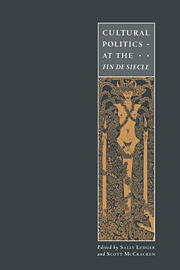Book contents
- Frontmatter
- Contents
- List of illustrations
- Notes on contributors
- Acknowledgements
- Introduction
- 1 The flight to the real
- 2 The New Woman and the crisis of Victorianism
- 3 Empire, ‘race’ and feminism at the fin de siècle: the work of George Egerton and Olive Schreiner
- 4 W. B. Yeats and Irish cultural politics in the 1890s
- 5 The double lives of man: narration and identification in late nineteenth-century representations of ec-centric masculinities
- 6 Henry James and the spectacle of loss: psychoanalytic metaphysics
- 7 ‘A very curious construction’: masculinity and the poetry of A. E. Housman and Oscar Wilde
- 8 The Pilgrims of Hope: William Morris and the dialectic of romanticism
- 9 Urban utopias: socialism, religion and the city, 1880 to 1900
- 10 Vampires and the empire: fears and fictions of the 1890s
- 11 Utopia, Limited: nationalism, empire and parody in the comic operas of Gilbert and Sullivan
- 12 Technologies of monstrosity: Bram Stoker's Dracula
- 13 Postmodernism, a Chance to reread?
- 14 Is market society the fin of history?
- Select bibliography
- Index
13 - Postmodernism, a Chance to reread?
Published online by Cambridge University Press: 29 September 2009
- Frontmatter
- Contents
- List of illustrations
- Notes on contributors
- Acknowledgements
- Introduction
- 1 The flight to the real
- 2 The New Woman and the crisis of Victorianism
- 3 Empire, ‘race’ and feminism at the fin de siècle: the work of George Egerton and Olive Schreiner
- 4 W. B. Yeats and Irish cultural politics in the 1890s
- 5 The double lives of man: narration and identification in late nineteenth-century representations of ec-centric masculinities
- 6 Henry James and the spectacle of loss: psychoanalytic metaphysics
- 7 ‘A very curious construction’: masculinity and the poetry of A. E. Housman and Oscar Wilde
- 8 The Pilgrims of Hope: William Morris and the dialectic of romanticism
- 9 Urban utopias: socialism, religion and the city, 1880 to 1900
- 10 Vampires and the empire: fears and fictions of the 1890s
- 11 Utopia, Limited: nationalism, empire and parody in the comic operas of Gilbert and Sullivan
- 12 Technologies of monstrosity: Bram Stoker's Dracula
- 13 Postmodernism, a Chance to reread?
- 14 Is market society the fin of history?
- Select bibliography
- Index
Summary
‘You understand?’ he asked.
‘Perfectly,’ I said, ‘You are an expert in the psychological wilderness. This is like one of those Redskin stories where the noble savages carry off a girl and an honest backswoodman with his incomparable knowledge follows the track and reads the signs of her fate in a footprint here, a broken twig there, a trinket dropped by the way. I have always liked such stories. Go on.’
Marlow smiled indulgently at my jesting. ‘It is not exactly a story for boys,’ he said.
(Joseph Conrad, Chance)If Joseph Conrad's Chance is not exactly a story for boys, then neither is it, as it was advertised, a story for women. Instead, the novel is difficult to categorize on a number of levels. It has an anomalous position within Conrad's work. Critics who have favoured Conrad's style as part of the beginnings of high modernism have seen the novel's popular elements as evidence of his decline. Its content differs markedly from Marlow's earlier tales like Heart of Darkness and Lord Jim. In contrast to the way women are excluded or marginalized in those texts, Chance contains three New Woman characters, Flora de Barral, Mrs Fyne and the (unnamed) governess. The plot revolves around the transactions and crises of finance capital and international trade as well as the politics of personal identity. In terms of form, the narrative is unusually (even by Conrad's standards) discontinuous and disruptive and the authority of the veteran narrator is constantly questioned.
- Type
- Chapter
- Information
- Cultural Politics at the Fin de Siècle , pp. 267 - 289Publisher: Cambridge University PressPrint publication year: 1995



